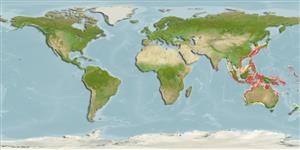Environment: milieu / climate zone / depth range / distribution range
นิเวศวิทยา
เกี่ยวกับทะเล,น้ำเค็ม สัตว์น้ำหน้าดิน; ระดับความลึก 79 - 100 m (Ref. 9824). Tropical
Western Pacific: southern Japan to the South China Sea. Also known from Darwin to North West Cape, Australia (Ref. 5978); southern Indonesia (Ref. 9824); the Philippines (Ref. 9494).
ขนาด / น้ำหนัก / Age
Maturity: Lm ? range ? - ? cm
Max length : 13.0 cm SL เพศผู้/กระเทย; (Ref. 9824)
เงี่ยงครีบหลัง (รวม) : 0; ก้านครีบอ่อนที่หาง (รวม) : 90 - 103; เงี่ยงครีบก้น: 0; ก้านครีบอ่อนที่ก้น: 69 - 80. Differs from P. iijimae by dark spots on body not extending to dorsal and anal fins, caudal fin without blackish band, and absence of gill rakers on upper limb. Snout and jaws dark.
Inhabits sand and mud bottoms. Caught with shrimp bottom trawls.
Life cycle and mating behavior
Maturities | การสืบพันธุ์ | Spawnings | Egg(s) | Fecundities | ตัวอ่อน
Masuda, H., K. Amaoka, C. Araga, T. Uyeno and T. Yoshino, 1984. The fishes of the Japanese Archipelago. Vol. 1. Tokai University Press, Tokyo, Japan. 437 p. (text). (Ref. 559)
IUCN Red List Status (Ref. 130435)
Threat to humans
Harmless
Human uses
การประมง: ไม่มีผลประโยชน์
เครื่องมือ
Special reports
Download XML
แหล่งที่มาจากอินเตอร์เน็ต
Estimates based on models
Preferred temperature (Ref.
123201): 18.2 - 27.3, mean 25.2 °C (based on 71 cells).
Phylogenetic diversity index (Ref.
82804): PD
50 = 0.5010 [Uniqueness, from 0.5 = low to 2.0 = high].
Bayesian length-weight: a=0.00912 (0.00408 - 0.02036), b=3.05 (2.87 - 3.23), in cm total length, based on LWR estimates for this (Sub)family-body shape (Ref.
93245).
ระดับชั้นอาหาร (Ref.
69278): 3.7 ±0.4 se; based on size and trophs of closest relatives
ความสามารถในการกลับคืนสู่ปกติ (Ref.
120179): ขนาดกลาง, เวลาต่ำสุดที่จะทำให้ประชากรเพิ่มขึ้นเป็น 2 เท่าใช้เวลา 1.4 - 4.4 ปี (Preliminary K or Fecundity.).
Fishing Vulnerability (Ref.
59153): Low vulnerability (10 of 100).
